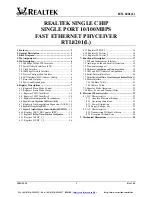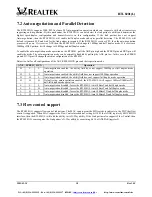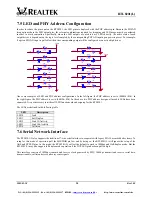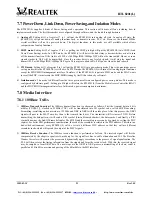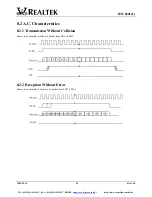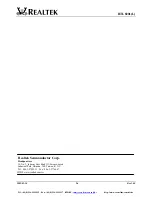
RTL8201(L)
2002-01-18
Rev.1.04
11
6.5. Register 4 Auto-negotiation Advertisement
(ANAR)
This register contains the advertised abilities of this device as they will be transmitted to its link partner during
Auto-negotiation.
Address
Name
Description/Usage
Default/Attribute
4:<15> NP
Next Page:
The RTL8201L does not implement the Next Page function,
so bit 15 will always return a ‘0’ when read.
0: Transmitting the primary capability data page
1: Transmitting the protocol specific data page
0, RO
4:<14> ACK
Acknowledge:
Because the Next Page function is not implemented, bit
14 will always return a ‘0’ when read.
1: Acknowledge reception of link partner capability data word
0: Do not acknowledge reception
0, RO
4:<13> RF
Remote Fault:
Bit 13 returns a value of ‘1’ when the RTL8201L has
detected a remote fault. The RTL8201L advertises this information, but
does not act upon it.
1: Advertise remote fault detection capability
0: Do not advertise remote fault detection capability
0, RW
4:<12:11> Reserved
Reserved:
Ignore the output of the RTL8201L when these bits are
read.
4:<10> Pause
Pause:
The use of this bit is independent of the negotiated data rate,
medium, or link technology. Setting this bit indicates the availability of
additional DTE capabilities when full duplex operation is in use. This
bit is used by one MAC to communicate Pause Capability to its Link
Partner and has no effect on PHY operation.
1: Flow control is supported by local node
0: Flow control is NOT supported by local node
0, RW
4:<9> T4
100Base-T4:
This bit advertises the ability to the Link Partner that the
RTL8201L can operate in 100Base-T4 mode. Writing a ‘0’ to this bit
will suppress the transmission of this ability to the Link Partner.
Resetting the chip will restore the default value. The default value is ‘1’
and writing a ‘1’ will set this bit to ‘1’. Reading this bit will return the
last written value or the default value if no write has been completed
since the last reset.
1: 100Base-T4 is supported by local node
0: 100Base-T4 not supported by local node
0, RO
4:<8> TXFD
100Base-TX-FD:
This bit advertises the ability to the Link Partner that
the RTL8201L can operate in 100Base-TX full duplex mode. Writing a
‘0’ to this bit will suppress the transmission of this ability to the Link
Partner. Resetting the chip will restore the default value. The default
value is ‘1’ and writing a ‘1’ will set this bit to ‘1’. Reading this bit will
return the last written value or the default value if no write has been
completed since the last reset.
1: 100Base-TX full duplex is supported by local node
0: 100Base-TX full duplex not supported by local node
1, RW
4:<7> TX
100Base-TX:
This bit advertises the ability to the Link Partner that the
RTL8201L can operate in 100Base-TX half duplex mode. Writing a ‘0’
to this bit will suppress the transmission of this ability to the Link
Partner. Resetting the chip will restore the default value. The default
value is ‘1’ and writing a ‘1’ will set this bit to ‘1’. Reading this bit will
return the last written value or the default value if no write has been
completed since the last reset.
1: 100Base-TX is supported by local node
0: 100Base-TX not supported by local node
1, RW
Tel: +49(0)234-9351135 · Fax: +49(0)234-9351137
E-MAIL:
info@cornelius-consult.de
http://www.
cornelius-consult.de

